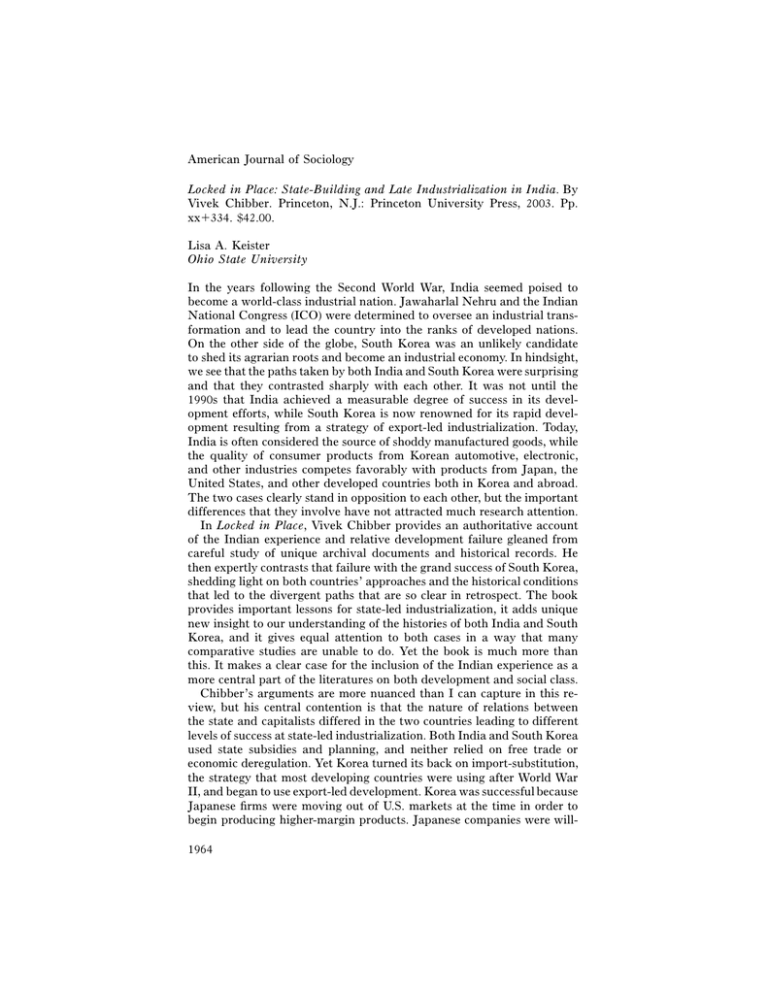American Journal of Sociology 1964 Locked in Place: State
advertisement

American Journal of Sociology Locked in Place: State-Building and Late Industrialization in India. By Vivek Chibber. Princeton, N.J.: Princeton University Press, 2003. Pp. xx⫹334. $42.00. Lisa A. Keister Ohio State University In the years following the Second World War, India seemed poised to become a world-class industrial nation. Jawaharlal Nehru and the Indian National Congress (ICO) were determined to oversee an industrial transformation and to lead the country into the ranks of developed nations. On the other side of the globe, South Korea was an unlikely candidate to shed its agrarian roots and become an industrial economy. In hindsight, we see that the paths taken by both India and South Korea were surprising and that they contrasted sharply with each other. It was not until the 1990s that India achieved a measurable degree of success in its development efforts, while South Korea is now renowned for its rapid development resulting from a strategy of export-led industrialization. Today, India is often considered the source of shoddy manufactured goods, while the quality of consumer products from Korean automotive, electronic, and other industries competes favorably with products from Japan, the United States, and other developed countries both in Korea and abroad. The two cases clearly stand in opposition to each other, but the important differences that they involve have not attracted much research attention. In Locked in Place, Vivek Chibber provides an authoritative account of the Indian experience and relative development failure gleaned from careful study of unique archival documents and historical records. He then expertly contrasts that failure with the grand success of South Korea, shedding light on both countries’ approaches and the historical conditions that led to the divergent paths that are so clear in retrospect. The book provides important lessons for state-led industrialization, it adds unique new insight to our understanding of the histories of both India and South Korea, and it gives equal attention to both cases in a way that many comparative studies are unable to do. Yet the book is much more than this. It makes a clear case for the inclusion of the Indian experience as a more central part of the literatures on both development and social class. Chibber’s arguments are more nuanced than I can capture in this review, but his central contention is that the nature of relations between the state and capitalists differed in the two countries leading to different levels of success at state-led industrialization. Both India and South Korea used state subsidies and planning, and neither relied on free trade or economic deregulation. Yet Korea turned its back on import-substitution, the strategy that most developing countries were using after World War II, and began to use export-led development. Korea was successful because Japanese firms were moving out of U.S. markets at the time in order to begin producing higher-margin products. Japanese companies were will1964 Book Reviews ing to exchange access to foreign markets for shares in Korea’s chaebol (business groups). India, and many other developing countries, were forced to focus on domestic markets, where they were protected from foreign competition but where they were also forced to focus on less lucrative, shoddier manufactured goods. Not only did India lack the historic good fortune of a ready entrée into the mature U.S. market that Korea enjoyed, but India’s capitalists also actively opposed the state’s planning efforts. Indian capitalists and Congress Party leaders worked together to weaken labor unions that might have opposed the capitalists in the years immediately following independence. Because there were few viable labor unions, capitalists were able to remain strong in the face of state planners whose strategies might have disciplined them. It became rational for Indian planners to award licenses that essentially gave certain companies monopoly rights, and the recipients of these licenses often held the rights for years in order to avert competition. Because the planners did not have enough support from higherlevel government agencies to withdraw the licenses, capitalists hoarded licenses and did not follow through on investments they promised. In contrast, Korean planners were backed by a united government with a clear vision, and the state’s plan was executed with few diversions. Chibber’s arguments are insightful and backed by significant empirical support. My only (very minor) complaint is that the book appears to be more narrow in its focus than it truly is. The lessons that Chibber’s research have for India are important, but the argument clearly extends beyond India. It is about other countries that have already developed (he will certainly force a reconsideration of the literature on Korean development) and about countries that are poised to develop next. State planners in China, for example, would have a great deal to learn from the arguments and lessons contained here. Moreover, as Chibber points out in the preface, many states have rejected state-led development strategies, but it is unlikely that state involvement in industry is a vestige of the past. Given that, the book’s findings have lessons for state-industry relations well beyond developing countries. I hope the book attracts the attention it deserves. Corporate Power in a Globalizing World: A Study in Elite Social Organization. By William K. Carroll. Ontario: Oxford University Press, 2004. Pp. 288. Patrick Akard Kansas State University This book examines the changing structure of corporate power in Canada from the mid-1970s to the mid-1990s through a network analysis of board interlocks among its largest corporations and financial institutions. Wil1965




